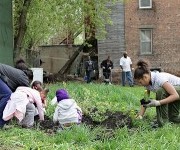Vacant lots are the scourge of cities around the world, and the recession has only exacerbated the problem. The pattern is one oft repeated: A person vacates a house or an elderly individual dies. Their survivors, if they have any close by, may not pay the outstanding property tax bill, either by choice or lack of financial options. Eventually the house falls into disrepair, until one day it’s either bulldozed or burns to the ground, either by accident or arson. Regardless of the exact process, the outcome is always the same — an empty lot overgrown by weeds.
Cities spend big money to first tear down decrepit houses and then mow the resulting empty lot. But they can only do that for so long before the expense becomes too great. Cleveland, for example, spends $3.3 million a year to keep the grass on over 20,000 vacant lots below eight inches. It’s a tidy sum in a time of shrinking tax revenues.
Some abandoned lots are donated to nonprofits to turn into parks or urban farms, but the amount of vacant land is growing at too fast a rate — cities and organizations can’t clean the lots up quickly enough to convert them into other uses. Even after cleanup, there simply isn’t enough demand for such open space from the shrinking populace. Over time many cities give up, letting weeds reclaim the lots. But that doesn’t mean it’s a hopeless cycle, and a lovely article in the The New York Times last week highlighted how a city can break free.
Cleveland is the article’s ground zero. The city’s population has been dwindling since the 1950s, and as a result, the number of vacant lots has been swelling. While Cleveland has up to 100 acres dedicated to urban farming by one estimate, that pales in comparison to the total vacant space of 3,600 acres. But where there’s disaster, there’s also opportunity. Michael Tortorello, the author of the Times article, sums it up succinctly:
One abandoned yard is a mess; 20,000 abandoned yards is an ecosystem. At this scale, Cleveland’s vacant land begins to look less like a sign of neglect and more like an ecological experiment spread over some 3,600 acres.
As it happens, a team of local scientists has designated this accidental landscape an Urban Long-Term Research Area — that is, Ultra. And having won a $272,000 exploratory award from the National Science Foundation, the researchers call their project Ultra-Ex. There’s enough turf here for everybody: Ultra-Ex scientists are studying bird and insect populations, watershed systems, soil nematodes and urban farms.
Tortello continues, pointing out the myriad niches that exist in vacant lots and species that fill them. By its end, the article leaves you with a warm feeling towards abandoned properties. It lays bare their possibilities — if only we could just get past the weeds, both literally and psychologically. Therein, I think, lies the crux of the problem.
Cities are, in general, tended and manicured environments. This is why people sincerely appreciate it when an urban farm moves in next door. Farms transform the land into productive members of the urban environment. Vacant lots seem like the opposite of this. They are the chaos that results when people leave, flowerbeds overflow, and weeds rush in. But overgrown properties only appear useless. Weeds are merely interlopers, breaking up compacted soil for later successional stages, ones characterized more by maples and oaks than thistles and dandelions.
Ultra-Ex in Cleveland and other urban ecological research projects can show cities the value of forsaking mowing without giving up. Rather, cities and nonprofits can work to seed the next stage of ecological succession, helping to push the lots through their weedy phase. It could be a cheaper solution than mowing, and in the end may create neighborhoods in which people will want to live again. After all, the difference between a weedy lot that’s a nuisance and a desirable wooded property is just a few decades of plant growth.





